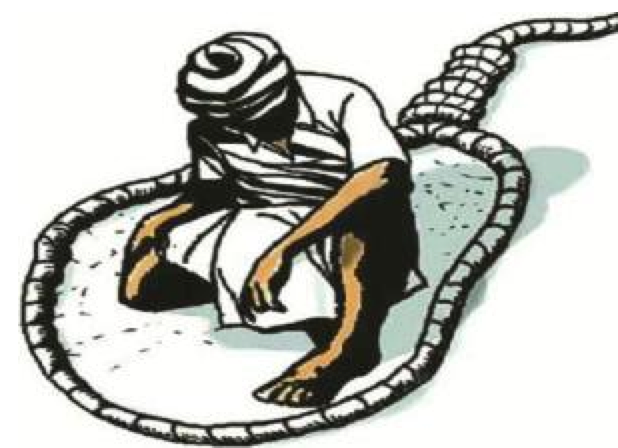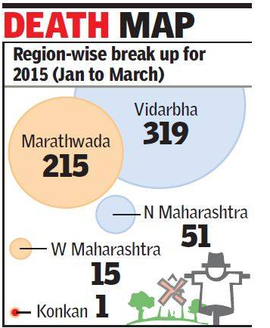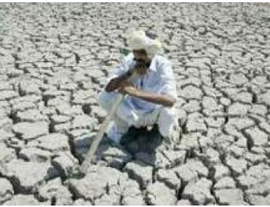BEED: He had his hopes pinned on his tiny field of jowar. Sandeep Shinde had carefully nurtured it after the drought singed his cotton crop last October. Yet days before the new crop was due for harvest last week, the rain pelted down hard. The jowar stalks collapsed into the mud and the grain turned black. A few hours later, the 27-year-old hung himself with a nylon rope from a tree in his field in Patoda taluka.

Shinde had not managed a decent crop in the last three years in this arid belt, running up debts of 1.2 lakh. The drought and bouts of rain wrecked his chances of breaking even. "He was worried about his loans and talked of migrating," says family friend Rajabhau Deshmukh.
His widow Shobha is anxious about her four-year-old son and one-year-old daughter. "I cannot even afford milk for the children," she says.

In a state where farmer suicides have become endemic, the widespread drought followed by freak rains and hailstorms have pushed many more over the edge. In many cases, the calamities claimed two successive crops.
Farmer suicides shot up by over 40% in the last seven months when the impact of these twin calamities kicked in compared to the same span last year, state government data shows. The state reported 975 suicides by farmers between January to July 2014. The figure rose to a steep 1,373 between August 2014, when the drought set in, and February 2015.
The region of Marathwada, which was among those worst hit by the drought, has seen the sharpest increase in suicides by farmers during the same period. The suicides here have risen by 85%. Every single village in the region was declared drought-affected.
Even large land-holders are committing suicide in Georai, which is part of Aurangabad's Beed district and is located close to the Jayakwadi dam. Gangadhar Shendge, who committed suicide two weeks ago, had an 18-acre farm. "Our entire kharif crop was ruined. We did not sow the rabi crop at all," says his son Mahadev Shendge. Across the state, sowing for the rabi winter crop was down by 40%.
Officials say the state is facing a potent combination of three types of drought. "The poor rain points to meterological drought, ground water depletion signals hydrological drought. And the drop in yield means we have agricultural drought as well," says Aurangabad divisional commissioner Umakant Dangat.
He attributes the changing weather patterns to climate change. "The late arrival and early withdrawal of the monsoon, the long gaps between bouts of rain and the freak hailstorms, point to climate change," he says.
Farming economics don't add up
But the vagaries of nature apart, experts say the economics of farming are tilted against the farmer even at the best of times. "The farmer is facing low yield because of the drought. Add to this the high price of cultivation and low price for the crop. How is he expected to survive?" asks farming activist Vijay Jawandia.
The minimum cost of production for a quintal of cotton is Rs 5,200. The market price for a quintal last year was Rs 5,000, which means the farmer could break even. Today the price is only Rs 3,600-3,800, Jawandia points out.
Bizarre policies like encouraging the water-guzzling sugarcane crop in this drought-prone zone have added to the water stress, experts say. Marathwada has 2.4 lakh hectares under the crop and boasts of 61 sugar factories.
"The water used for one hectare of sugarcane can irrigate over 8 hectares of rabi jowar. It should not be grown in arid regions. Sugarcane occupies five per cent of the state's land but commands 60 per cent of its irrigation water," points out Pradeep Purandare, expert member of the Marathwada Statutory Development Board.
Irrigation facilities in Marathwada remain rudimentary. But even the potential created is poorly utilized. Of the 10 lakh hectares of irrigation potential created in Marathwada, just three lakh hectares are utilized, according to the divisional commissioner.
The poor management of irrigation facilities has resulted in the rampant exploitation of ground-water, as farmers turn to borewells and tubewells. The majority of talukas in the region are reporting a dip in ground water levels compared to the last five years, escalating the water crisis in the region.
Photos: Shaikh Aziz
Report 4: The original version of this story appeared in The Times of India on 22 March 2015
More in this series:
Report 1:
Nearly 80000 homeless elders go hungry
Report 2:
Drought hits 90 lakhs farmers in Maharashtra
Report 3:
Kharif crops hit by drought pulses take a maha pounding
Report 5:
Bitter Harvest - Where villagers dig for hours to fill a pot
Report 6:
Drought migration forces aged to toil as farm hands
Report 7:
The man with 48 borewells in drought-hit Marathwada
Report 8:
Maharashtra's drought-hit farmers without bank accounts denied aid
Report 9:
Maharashtra govt says mulling farmer insurance as opposition cites TOI’s suicide reports
Report 10:
Study: Agri-corporates, not farmers, hog loans
Report 11:
Direct loans below Rs 25,000 to farmers plunge to 4.3% from 23%
Report 12:
Only 12% potential of Maharashtra’s 70,000 small dams used
Report 13:
Unseasonal rain: 601 farmer suicides in Maharashra in just 3 months
Report 14:
'Only 3 Maharashtra farmers ended life due to unseasonal rain'
Report 15:
State government's logic for its low farmer suicide count: Only 3 blamed rains
Report 16:
Beef banned, but no state-run cow shelters in sight


